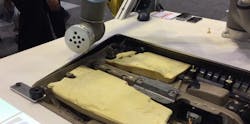By now, you’ve likely heard about augmented reality use in maintenance and repair operations in various OEM applications. I learned today that augmented reality is a wider term that can be applied beyond the traditional superimposed graphics on real world images via headsets, eyewear or handheld devices.
At the Universal Robots booth at Automate in Chicago, I had the opportunity see how collaborative robots could work together with humans where the augmented reality (AR) experience is delivered via instructions to guide the operator through the tasks that need to be completed. In some cases, the AR is delivered via textual instructions projected into the operator’s workspace. It is also delivered via flashing lights and shapes to direct the operator’s attention and actions in specific work areas.
In the video below, you can see how collaborative robots and AR technologies can be combined for door assembly operations in an automotive manufacturing facility. The AR technology in this example is from Light Guide Systems and the application was built by system integrator Kubica.
Leaders relevant to this article:


